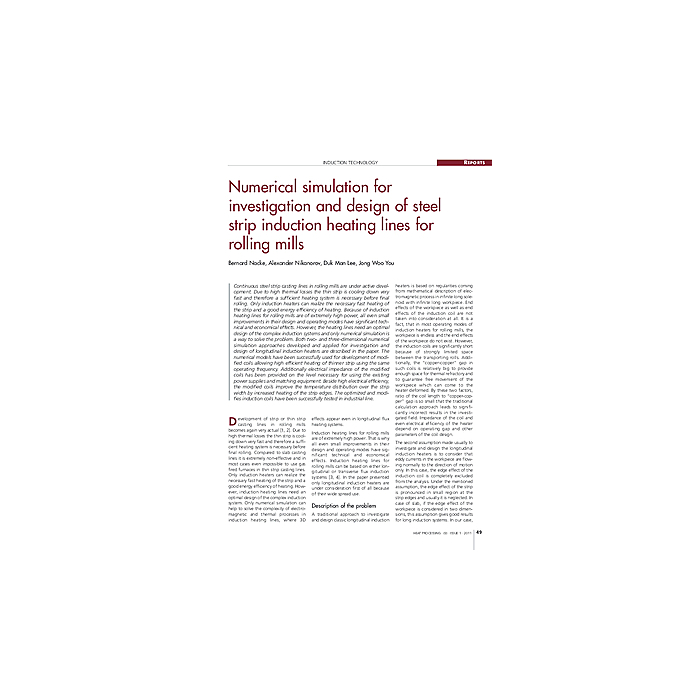Numerical simulation for investigation and design of steel strip induction heating lines for rolling mills
4,90 €
Auf Lager
Artikelnummer
00541_2011_01_05
Continuous steel strip casting lines in rolling mills are under active development. Due to high thermal losses the thin strip is cooling down very fast and therefore a sufficient heating system is necessary before final rolling. Only induction heaters can realize the necessary fast heating of the strip and a good energy efficiency of heating. Because of induction heating lines for rolling mills are of extremely high power, all even small improvements in their design and operating modes have significant technical and economical effects. However, the heating lines need an optimal design of the complex induction systems and only numerical simulation is a way to solve the problem. Both two- and three-dimensional numerical simulation approaches developed and applied for investigation and design of longitudinal induction heaters are described in the paper. The numerical models have been successfully used for development of modified coils allowing high efficient heating of thinner strip using the same operating frequency. Additionally electrical impedance of the modified coils has been provided on the level necessary for using the existing power supplies and matching equipment. Beside high electrical efficiency, the modified coils improve the temperature distribution over the strip width by increased heating of the strip edges. The optimized and modifies induction coils have been successfully tested in industrial line.
| Autoren | Bernard Nacke/Alexander Nikanorov, Duk Man Lee, Jong Woo You |
|---|---|
| Erscheinungsdatum | 01.01.2011 |
| Format | |
| Zeitschrift | heat processing - Issue 01 2011 |
| Verlag | Vulkan-Verlag GmbH |
| Sprache | English |
| Seitenzahl | 6 |
| Titel | Numerical simulation for investigation and design of steel strip induction heating lines for rolling mills |
| Beschreibung | Continuous steel strip casting lines in rolling mills are under active development. Due to high thermal losses the thin strip is cooling down very fast and therefore a sufficient heating system is necessary before final rolling. Only induction heaters can realize the necessary fast heating of the strip and a good energy efficiency of heating. Because of induction heating lines for rolling mills are of extremely high power, all even small improvements in their design and operating modes have significant technical and economical effects. However, the heating lines need an optimal design of the complex induction systems and only numerical simulation is a way to solve the problem. Both two- and three-dimensional numerical simulation approaches developed and applied for investigation and design of longitudinal induction heaters are described in the paper. The numerical models have been successfully used for development of modified coils allowing high efficient heating of thinner strip using the same operating frequency. Additionally electrical impedance of the modified coils has been provided on the level necessary for using the existing power supplies and matching equipment. Beside high electrical efficiency, the modified coils improve the temperature distribution over the strip width by increased heating of the strip edges. The optimized and modifies induction coils have been successfully tested in industrial line. |
Eigene Bewertung schreiben


